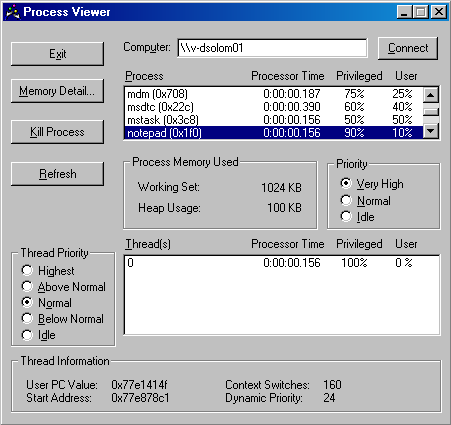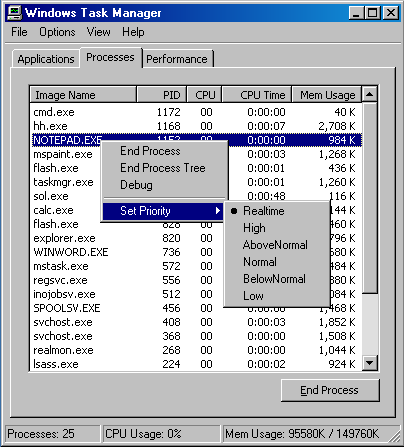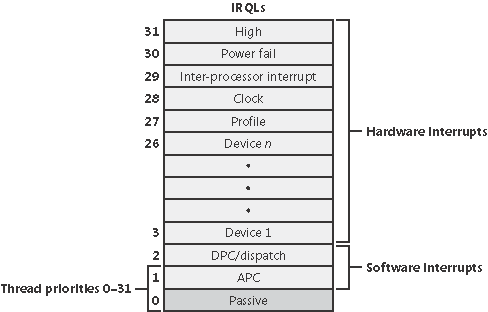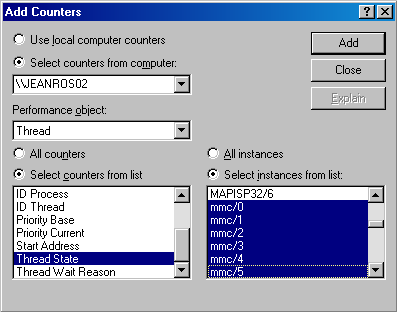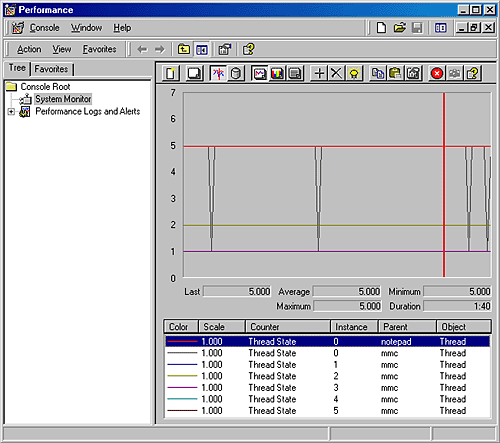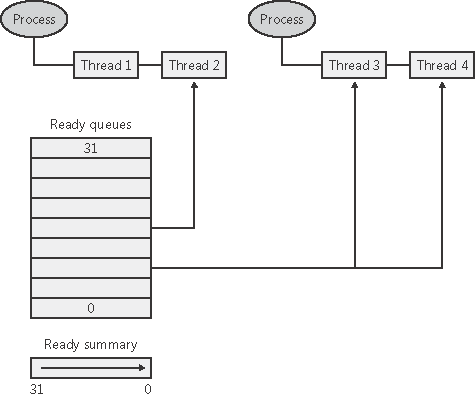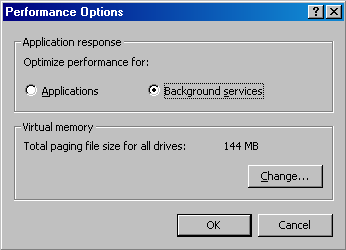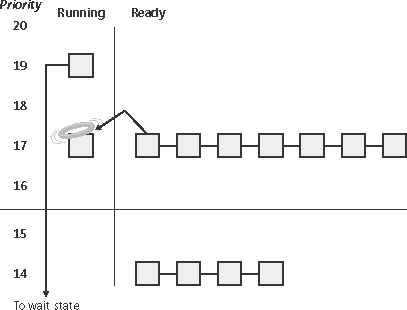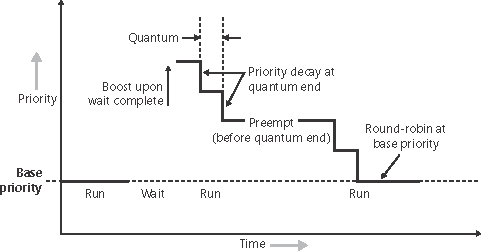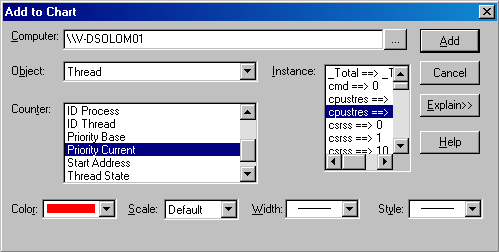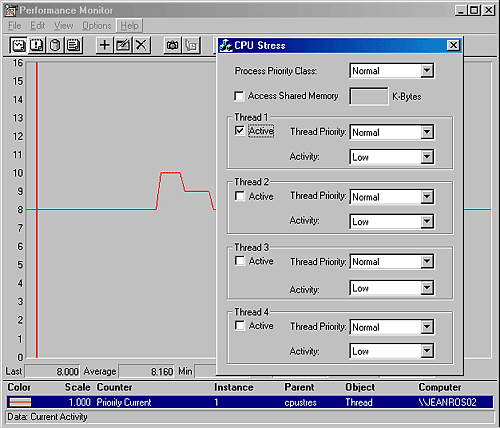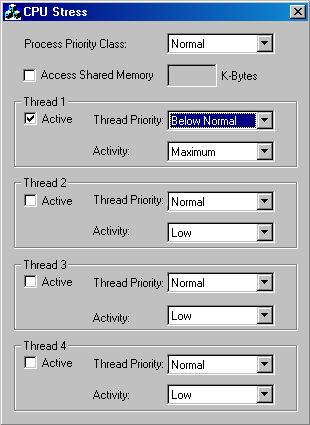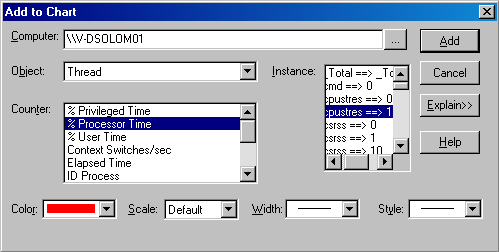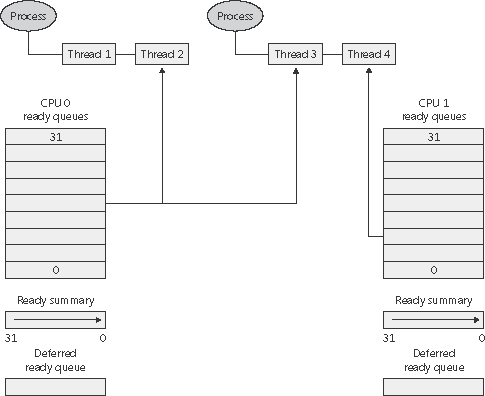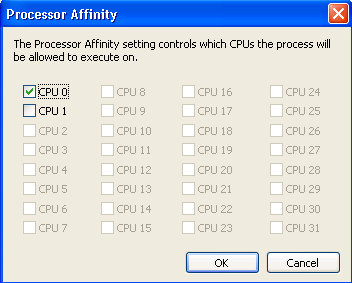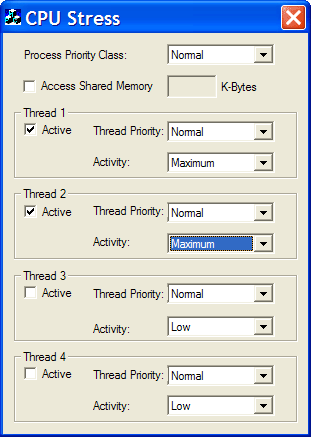Thread Scheduling
| < Day Day Up > |
| This section describes the Windows scheduling policies and algorithms. The first subsection provides a condensed description of how scheduling works on Windows and a definition of key terms. Then Windows priority levels are described from both the Windows API and the Windows kernel points of view. After a review of the relevant Windows functions and _Windows utilities and tools that relate to scheduling, the detailed data structures and algorithms that make up the Windows scheduling system are presented, with uniprocessor systems examined first and then multiprocessor systems. Overview of Windows SchedulingWindows implements a priority-driven, preemptive scheduling system the highest-priority runnable (ready) thread always runs, with the caveat that the thread chosen to run might be limited by the processors on which the thread is allowed to run, a phenomenon called processor affinity. By default, threads can run on any available processor, but you can alter processor affinity by using one of the Windows scheduling functions listed in Table 6-13 (shown later in the chapter) or by setting an affinity mask in the image header.
When a thread is selected to run, it runs for an amount of time called a quantum. A quantum is the length of time a thread is allowed to run before another thread at the same priority level (or higher, which can occur on a multiprocessor system) is given a turn to run. Quantum values can vary from system to system and process to process for any of three reasons: system configuration settings (long or short quantums), foreground/background status of the process, or use of the job object to alter the quantum. (Quantums are described in more detail in the "Quantum" section later in the chapter.) A thread might not get to complete its quantum, however. Because Windows implements a preemptive scheduler, if another thread with a higher priority becomes ready to run, the currently running thread might be preempted before finishing its time slice. In fact, a thread can be selected to run next and be preempted before even beginning its quantum! The Windows scheduling code is implemented in the kernel. There's no single "scheduler" module or routine, however the code is spread throughout the kernel in which schedulingrelated events occur. The routines that perform these duties are collectively called the kernel's dispatcher. The following events might require thread dispatching:
At each of these junctions, Windows must determine which thread should run next. When Windows selects a new thread to run, it performs a context switch to it. A context switch is the procedure of saving the volatile machine state associated with a running thread, loading another thread's volatile state, and starting the new thread's execution. As already noted, Windows schedules at the thread granularity. This approach makes sense when you consider that processes don't run but only provide resources and a context in which their threads run. Because scheduling decisions are made strictly on a thread basis, no consideration is given to what process the thread belongs to. For example, if process A has 10 runnable threads, process B has 2 runnable threads, and all 12 threads are at the same priority, each thread would theoretically receive one-twelfth of the CPU time Windows wouldn't give 50 percent of the CPU to process A and 50 percent to process B. Priority LevelsTo understand the thread-scheduling algorithms, you must first understand the priority levels that Windows uses. As illustrated in Figure 6-12, internally, Windows uses 32 priority levels, ranging from 0 through 31. These values divide up as follows: Figure 6-12. Thread priority levels
Thread priority levels are assigned from two different perspectives: those of the Windows API and those of the Windows kernel. The Windows API first organizes processes by the priority class to which they are assigned at creation (Real-time, High, Above Normal, Normal, Below Normal, and Idle) and then by the relative priority of the individual threads within those processes (Time-critical, Highest, Above-normal, Normal, Below-normal, Lowest, and Idle). In the Windows API, each thread has a base priority that is a function of its process priority class and its relative thread priority. The mapping from Windows priority to internal Windows numeric priority is shown in Figure 6-13. Figure 6-13. Mapping of Windows kernel priorities to the Windows API
Whereas a process has only a single base priority value, each thread has two priority values: current and base. Scheduling decisions are made based on the current priority. As explained in the following section on priority boosting, the system under certain circumstances increases the priority of threads in the dynamic range (1 through 15) for brief periods. Windows never adjusts the priority of threads in the real-time range (16 through 31), so they always have the same base and current priority. A thread's initial base priority is inherited from the process base priority. A process, by default, inherits its base priority from the process that created it. This behavior can be overridden on the CreateProcess function or by using the command-line START command. A process priority can also be changed after being created by using the SetPriorityClass function or various tools that expose that function such as Task Manager and Process Explorer (by right-clicking on the process and choosing a new priority class). For example, you can lower the priority of a CPU-intensive process so that it does not interfere with normal system activities. Changing the priority of a process changes the thread priorities up or down, but their relative settings remain the same. It usually doesn't make sense, however, to change individual thread priorities within a process, because unless you wrote the program or have the source code, you don't really know what the individual threads are doing, and changing their relative importance might cause the program not to behave in the intended fashion. Normally, the process base priority (and therefore the starting thread base priority) will default to the value at the middle of each process priority range (24, 13, 10, 8, 6, or 4). However, some Windows system processes (such as the Session Manager, service controller, and local security authentication server) have a base process priority slightly higher than the default for the Normal class (8). This higher default value ensures that the threads in these processes will all start at a higher priority than the default value of 8. These system processes use an internal system call (NtSetInformationProcess) to set its process base priority to a numeric value other than the normal default starting base priority. Windows Scheduling APIsThe Windows API functions that relate to thread scheduling are listed in Table 6-13. (For more information, see the Windows API reference documentation.) Relevant ToolsThe following table lists the tools related to thread scheduling. You can change (and view) the base process priority with a number of different tools, such as Task Manager, Process Explorer, Pview, or Pviewer. Note that you can kill individual threads in a process with Process Explorer. This should be done, of course, with extreme care. You can view individual thread priorities with the Performance tool, Process Explorer, Pslist, Pview, Pviewer, and Pstat. While it might be useful to increase or lower the priority of a process, it typically does not make sense to adjust individual thread priorities within a process because only a person who thoroughly understands the program would understand the relative importance of the threads within the process.
The only way to specify a starting priority class for a process is with the start command in the Windows command prompt. If you want to have a program start every time with a specific priority, you can define a shortcut to use the start command by beginning the command with cmd /c. This runs the command prompt, executes the command on the command line, and terminates the command prompt. For example, to run Notepad in the low-process priority, the shortcut would be cmd /c start /low notepad.exe.
Real-Time PrioritiesYou can raise or lower thread priorities within the dynamic range in any application; however, you must have the increase scheduling priority privilege to enter the real-time range. Be aware that many important Windows kernel-mode system threads run in the real-time priority range, so if threads spend excessive time running in this range, they might block critical system functions (such as in the memory manager, cache manager, or other device drivers). Note
Thread StatesBefore you can comprehend the thread-scheduling algorithms, you need to understand the various execution states that a thread can be in. Figure 6-14 illustrates the state transitions for threads on Windows 2000 and Windows XP. (The numeric values shown represent the value of the thread state performance counter.) More details on what happens at each transition are included later in this section. Figure 6-14. Thread states on Windows 2000 and Windows XP
The thread states are as follows:
The state diagram for threads on Windows Server 2003 is shown in Figure 6-15. Notice the new state called deferred ready. This state is used for threads that have been selected to run on a specific processor but have not yet been scheduled. This new state exists so that the kernel can minimize the amount of time the systemwide lock on the scheduling database is held. (This process is explained further in the section "Multiprocessor Dispatcher Database.") Figure 6-15. Thread states on Windows Server 2003
Dispatcher DatabaseTo make thread-scheduling decisions, the kernel maintains a set of data structures known collectively as the dispatcher database, illustrated in Figure 6-16. The dispatcher database keeps track of which threads are waiting to execute and which processors are executing which threads. Figure 6-16. Dispatcher database (uniprocessor and Windows 2000/XP multiprocessor)
Note
The dispatcher ready queues (KiDispatcherReadyListHead) contain the threads that are in the ready state, waiting to be scheduled for execution. There is one queue for each of the 32 priority levels. To speed up the selection of which thread to run or preempt, Windows maintains a 32-bit bit mask called the ready summary (KiReadySummary). Each bit set indicates one or more threads in the ready queue for that priority level. (Bit 0 represents priority 0, and so on.) Table 6-15 lists the kernel-mode kernel variables that are related to thread scheduling on uniprocessor systems.
On uniprocessor systems, the dispatcher database is synchronized by raising IRQL to DPC/ dispatch level and SYNCH_LEVEL (both of which are defined as level 2). (For an explanation of interrupt priority levels, see the "Trap Dispatching" section in Chapter 3.) Raising IRQL in this way prevents other threads from interrupting thread dispatching because threads normally run at IRQL 0 or 1. On multiprocessor systems, more is required than raising IRQL because each processor can, at the same time, raise to the same IRQL and attempt to operate on the dispatcher database. How Windows synchronizes access to the dispatcher database on multiprocessor systems is explained in the "Multiprocessor Systems" section later in the chapter. QuantumAs mentioned earlier in the chapter, a quantum is the amount of time a thread gets to run before Windows checks to see whether another thread at the same priority is waiting to run. If a thread completes its quantum and there are no other threads at its priority, Windows permits the thread to run for another quantum. On Windows 2000 Professional and Windows XP, threads run by default for 2 clock intervals; on Windows Server systems, by default, a thread runs for 12 clock intervals. (We'll explain how you can change these values later.) The rationale for the longer default value on server systems is to minimize context switching. By having a longer quantum, server applications that wake up as the result of a client request have a better chance of completing the request and going back into a wait state before their quantum ends. The length of the clock interval varies according to the hardware platform. The frequency of the clock interrupts is up to the HAL, not the kernel. For example, the clock interval for most x86 uniprocessors is about 10 milliseconds and for most x86 multiprocessors it is about 15 milliseconds. (The actual clock rate is not exactly a round number of milliseconds see the following experiment for a way to check the actual clock interval.)
Quantum AccountingEach process has a quantum value in the kernel process block. This value is used when giving a thread a new quantum. As a thread runs, its quantum is reduced at each clock interval. If there is no remaining thread quantum, the quantum end processing is triggered. If there is another thread at the same priority waiting to run, a context switch occurs to the next thread in the ready queue. Note that when the clock interrupt interrupts a DPC or another interrupt that was in progress, the thread that was in the running state has its quantum deducted, even if it hadn't been running for a full clock interval. If this was not done and device interrupts or DPCs occurred right before the clock interval timer interrupts, threads might not ever get their quantum reduced. Internally, the quantum value is stored as a multiple of three times the number of clock ticks. This means that on Windows 2000 and Windows XP systems, threads, by default, have a quantum value of 6 (2 * 3), and Windows Server systems have a quantum value of 36 (12 * 3). Each time the clock interrupts, the clock-interrupt routine deducts a fixed value (3) from the thread quantum. The reason quantum is stored internally in terms of a multiple of 3 quantum units per clock tick rather than as single units is to allow for partial quantum decay on wait completion. When a thread that has a current priority less than 16 and a base priority less than 14 executes a wait function (such as WaitForSingleObject or WaitForMultipleObjects) that is satisfied immediately (for example, without having to wait), its quantum is reduced by 1 quantum unit. In this way, threads that wait will eventually expire their quantum. In the case where a wait is not satisfied immediately, threads below priority 16 also have their quantum reduced by 1 unit (except if the thread is waking up to execute a kernel APC because the wait code will charge the quantum after the wait is actually satisfied). However, before doing the reduction, if the thread is at priority 14 or above, its quantum is reset to a full turn. This is also done for threads running at less than 14 if they are not running with a special priority boost (such as is done for foreground processes or in the case of CPU starvation) and if they are receiving a priority boost as a result of the unwait operation. (Priority boosting is explained in the next section.) This partial decay addresses the case in which a thread enters a wait state before the clock interval timer fires. If this adjustment were not made, it would be possible for threads never to have their quantums reduced. For example, if a thread ran, entered a wait state, ran again, and entered another wait state but was never the currently running thread when the clock interval timer fired, it would never have its quantum charged for the time it was running. Note that this does not apply to zero timeout waits, but only wait operations that do not require waiting because all the wait conditions are fulfilled at the time of the wait. Controlling the QuantumYou can change the thread quantum for all processes, but you can choose only one of two settings: short (2 clock ticks, the default for client machines) or long (12 clock ticks, the default for server systems). Note
To change this on Windows 2000, right click My Computer, Properties (or go to Control Panel and open the System settings applet), click the Advanced tab, and then click the Performance Options button. The dialog box you will see is shown in Figure 6-17. Figure 6-17. Quantum Configuration on Windows 2000
To change this on Windows XP and Windows Server 2003, right click My Computer, Properties, click the Advanced tab, click the Settings button in the Performance section, and finally click the Advanced tab. The dialog box displayed is slightly different for Windows XP and Windows Server 2003. These are shown in Figure 6-18. Figure 6-18. Quantum Configuration on Windows XP and Windows Server 2003 The Programs setting (called "Applications" on Windows 2000) designates the use of short, variable quantums the default for Windows 2000 Professional and Windows XP. If you install Terminal Services on Windows Server systems and configure the server as an application server, this setting is selected so that the users on the terminal server will have the same quantum settings that would normally be set on a desktop or client system. You might also select this manually if you were running Windows Server as your desktop operating system. The Background Services option designates the use of long, fixed quantums the default for Windows Server systems. The only reason why you might select this on a workstation system is if you were using the workstation as a server system. One additional difference between the Programs and Background Services settings is the effect they have on the quantum of the threads in the foreground process. This is explained in the next section. Quantum BoostingPrior to Windows NT 4.0, when a window was brought into the foreground on a workstation or client system, all the threads in the foreground process (the process that owns the thread that owns the window that's in focus) received a priority boost of 2. This priority boost remained in effect while any thread in the process owned the foreground window. The problem with this approach was that if you started a long-running, CPU-intensive process (such as a spreadsheet recalculation) and then switched to another CPU-intensive process (such as a computer-aided design tool, graphics editor, or a game), the process now running in the background would get little or no CPU time because the foreground process would have its threads boosted by 2 (assuming the base priority of the threads in both processes are the same) while it remained in the foreground. This default behavior was changed as of Windows NT 4.0 Workstation to instead triple the quantum of the threads in the foreground process. Thus, threads in the foreground process run with a quantum of 6 clock ticks, whereas threads in other processes have the default workstation quantum of 2 clock ticks. In this way, when you switch away from a CPU-intensive process, the new foreground process will get proportionally more of the CPU, because when its threads run they will have a longer turn that background threads (again, assuming the thread priorities are the same in both the foreground and background processes). Note that this adjustment of quantums applies only to processes with a priority higher than Idle on systems configured to Programs (or Applications, in Windows 2000) in the Performance Options settings described in the previous section. Thread quantums are not changed for the foreground process on systems configured to Background Services (the default on Windows Server systems). Quantum Settings Registry ValueThe user interface to control quantum settings described earlier modify the registry value HKLM\SYSTEM\CurrentControlSet\Control\PriorityControl\Win32PrioritySeparation. In addition to specifying the relative length of thread quantums (short or long), this registry value also defines whether or not threads in the foreground process should have their quantums boosted (and if so, the amount of the boost). This value consists of 6 bits divided into the three 2-bit fields shown in Figure 6-19. Figure 6-19. Fields of the Win32PrioritySeparation registry value
The fields shown in Figure 6-19 can be defined as follows:
Note that when you're using the Performance Options dialog box described earlier, you can choose from only two combinations: short quantums with foreground quantums tripled, or long quantums with no quantum changes for foreground threads. However, you can select other combinations by modifying the Win32PrioritySeparation registry value directly. Scheduling ScenariosWindows bases the question of "Who gets the CPU?" on thread priority; but how does this approach work in practice? The following sections illustrate just how priority-driven preemptive multitasking works on the thread level. Voluntary SwitchFirst a thread might voluntarily relinquish use of the processor by entering a wait state on some object (such as an event, a mutex, a semaphore, an I/O completion port, a process, a thread, a window message, and so on) by calling one of the Windows wait functions (such as WaitForSingleObject or WaitForMultipleObjects). Waiting for objects is described in more detail in Chapter 3. Figure 6-20 illustrates a thread entering a wait state and Windows selecting a new thread to run. Figure 6-20. Voluntary switching
In Figure 6-20, the top block (thread) is voluntarily relinquishing the processor so that the next thread in the ready queue can run (as represented by the halo it has when in the Running column). Although it might appear from this figure that the relinquishing thread's priority is being reduced, it's not it's just being moved to the wait queue of the objects the thread is waiting for. What about any remaining quantum for the thread? The quantum value isn't reset when a thread enters a wait state in fact, as explained earlier, when the wait is satisfied, the thread's quantum value is decremented by 1 quantum unit, equivalent to one-third of a clock interval (except for threads running at priority 14 or higher, which have their quantum reset after a wait to a full turn). PreemptionIn this scheduling scenario, a lower-priority thread is preempted when a higher-priority thread becomes ready to run. This situation might occur for a couple of reasons:
In either of these cases, Windows must determine whether the currently running thread should still continue to run or whether it should be preempted to allow a higher-priority thread to run. Note
When a thread is preempted, it is put at the head of the ready queue for the priority it was running at. Figure 6-21 illustrates this situation. Figure 6-21. Preemptive thread scheduling
In Figure 6-21, a thread with priority 18 emerges from a wait state and repossesses the CPU, causing the thread that had been running (at priority 16) to be bumped to the head of the ready queue. Notice that the bumped thread isn't going to the end of the queue but to the beginning; when the preempting thread has finished running, the bumped thread can complete its quantum. Quantum EndWhen the running thread exhausts its CPU quantum, Windows must determine whether the thread's priority should be decremented and then whether another thread should be scheduled on the processor. If the thread priority is reduced, Windows looks for a more appropriate thread to schedule. (For example, a more appropriate thread would be a thread in a ready queue with a higher priority than the new priority for the currently running thread.) If the thread priority isn't reduced and there are other threads in the ready queue at the same priority level, Windows selects the next thread in the ready queue at that same priority level and moves the previously running thread to the tail of that queue (giving it a new quantum value and changing its state from running to ready). This case is illustrated in Figure 6-22. If no other thread of the same priority is ready to run, the thread gets to run for another quantum. Figure 6-22. Quantum end thread scheduling
TerminationWhen a thread finishes running (either because it returned from its main routine, called Exit-Thread, or was killed with TerminateThread), it moves from the running state to the terminated state. If there are no handles open on the thread object, the thread is removed from the process thread list and the associated data structures are deallocated and released. Context SwitchingA thread's context and the procedure for context switching vary depending on the processor's architecture. A typical context switch requires saving and reloading the following data:
The kernel saves this information from the old thread by pushing it onto the current (old thread's) kernel-mode stack, updating the stack pointer, and saving the stack pointer in the old thread's KTHREAD block. The kernel stack pointer is then set to the new thread's kernel stack, and the new thread's context is loaded. If the new thread is in a different process, it loads the address of its page table directory into a special processor register so that its address space is available. (See the description of address translation in Chapter 7.) If a kernel APC that needs to be delivered is pending, an interrupt at IRQL 1 is requested. Otherwise, control passes to the new thread's restored instruction pointer and the new thread resumes execution. Idle ThreadWhen no runnable thread exists on a CPU, Windows dispatches the per-CPU idle thread. Each CPU is allotted one idle thread because on a multiprocessor system one CPU can be executing a thread while other CPUs might have no threads to execute. Various Windows process viewer utilities report the idle process using different names. Task Manager and Process Explorer call it "System Idle Process," Process Viewer reports it as "Idle," Pstat calls it "Idle Process," Process Explode and Tlist call it "System Process," and Qslice calls it "SystemProcess." Windows reports the priority of the idle thread as 0. In reality, however, the idle threads don't have a priority level because they run only when there are no real threads to run. (Remember, only one thread per Windows system is actually running at priority 0 the zero page thread, explained in Chapter 7.) The idle loop runs at DPC/dispatch level, polling for work to do, such as delivering deferred procedure calls (DPCs) or looking for threads to dispatch to. Although some details of the flow vary between architectures, the basic flow of control of the idle thread is as follows:
In Windows Server 2003, the idle thread also scans for threads waiting to run on other processors. (This is explained in the upcoming multiprocessor scheduling section.) Priority BoostsIn five cases, Windows can boost (increase) the current priority value of threads:
The intent of these adjustments is to improve overall system throughput and responsiveness as well as resolve potentially unfair scheduling scenarios. Like any scheduling algorithms, however, these adjustments aren't perfect, and they might not benefit all applications. Note
Priority Boosting after I/O CompletionWindows gives temporary priority boosts upon completion of certain I/O operations so that threads that were waiting for an I/O will have more of a chance to run right away and process whatever was being waited for. Recall that 1 quantum unit is deducted from the thread's remaining quantum when it wakes up so that I/O bound threads aren't unfairly favored. Although you'll find recommended boost values in the DDK header files (by searching for "#define IO" in Wdm.h or Ntddk.h), the actual value for the boost is up to the device driver. (These values are listed in Table 6-17.) It is the device driver that specifies the boost when it completes an I/O request on its call to the kernel function IoCompleteRequest. In Table 6-17, notice that I/O requests to devices that warrant better responsiveness have higher boost values.
The boost is always applied to a thread's base priority, not its current priority. As illustrated in Figure 6-23, after the boost is applied, the thread gets to run for one quantum at the elevated priority level. After the thread has completed its quantum, it decays one priority level and then runs another quantum. This cycle continues until the thread's priority level has decayed back to its base priority. A thread with a higher priority can still preempt the boosted thread, but the interrupted thread gets to finish its time slice at the boosted priority level before it decays to the next lower priority. Figure 6-23. Priority boosting and decay
As noted earlier, these boosts apply only to threads in the dynamic priority range (0 through 15). No matter how large the boost is, the thread will never be boosted beyond level 15 into the real-time priority range. In other words, a priority 14 thread that receives a boost of 5 will go up to priority 15. A priority 15 thread that receives a boost will remain at priority 15. Boosts after Waiting for Events and SemaphoresWhen a thread that was waiting for an executive event or a semaphore object has its wait satisfied (because of a call to the function SetEvent, PulseEvent, or ReleaseSemaphore), it receives a boost of 1. (See the value for EVENT_ INCREMENT and SEMAPHORE_INCREMENT in the DDK header files.) Threads that wait for events and semaphores warrant a boost for the same reason that threads that wait for I/O operations do threads that block on events are requesting CPU cycles less frequently than CPU-bound threads. This adjustment helps balance the scales. This boost operates the same as the boost that occurs after I/O completion, as described in the previous section:
A special boost is applied to threads that are awoken as a result of setting an event with the special functions NtSetEventBoostPriority (used in Ntdll.dll for critical sections) and KeSetEventBoostPriority (used for executive resources and push locks). If a thread waiting for an event is woken up as a result of the special event boost function and its priority is 13 or below, it will have its priority boosted to be the setting thread's priority plus one. If its quantum is less than 4 quantum units, it is set to 4 quantum units. This boost is removed at quantum end. Priority Boosts for Foreground Threads after WaitsWhenever a thread in the foreground process completes a wait operation on a kernel object, the kernel function KiUnwaitThread boosts its current (not base) priority by the current value of PsPrioritySeparation. (The windowing system is responsible for determining which process is considered to be in the foreground.) As described in the section on quantum controls, PsPrioritySeparation reflects the quantum-table index used to select quantums for the threads of foreground applications. However, in this case, it is being used as a priority boost value. The reason for this boost is to improve the responsiveness of interactive applications by giving the foreground application a small boost when it completes a wait, it has a better chance of running right away, especially when other processes at the same base priority might be running in the background. Unlike other types of boosting, this boost applies to all Windows systems, and you can't disable this boost, even if you've disabled priority boosting using the Windows SetThreadPriorityBoost function.
Priority Boosts after GUI Threads Wake UpThreads that own windows receive an additional boost of 2 when they wake up because of windowing activity, such as the arrival of window messages. The windowing system (Win32k.sys) applies this boost when it calls KeSetEvent to set an event used to wake up a GUI thread. The reason for this boost is similar to the previous one to favor interactive applications.
Priority Boosts for CPU StarvationImagine the following situation: you have a priority 7 thread that's running, preventing a priority 4 thread from ever receiving CPU time; however, a priority 11 thread is waiting for some resource that the priority 4 thread has locked. But because the priority 7 thread in the middle is eating up all the CPU time, the priority 4 thread will never run long enough to finish whatever it's doing and release the resource blocking the priority 11 thread. What does Windows do to address this situation? Once per second, the balance set manager (a system thread that exists primarily to perform memory management functions and is described in more detail in Chapter 7) scans the ready queues for any threads that have been in the ready state (that is, haven't run) for approximately 4 seconds. If it finds such a thread, the balance set manager boosts the thread's priority to 15. On Windows 2000 and Windows XP, the thread quantum is set to twice the process quantum. On Windows Server 2003, the quantum is set to 4 quantum units. Once the quantum is expired, the thread's priority decays immediately to its original base priority. If the thread wasn't finished and a higher priority thread is ready to run, the decayed thread will return to the ready queue, where it again becomes eligible for another boost if it remains there for another 4 seconds. The balance set manager doesn't actually scan all ready threads every time it runs. To minimize the CPU time it uses, it scans only 16 ready threads; if there are more threads at that priority level, it remembers where it left off and picks up again on the next pass. Also, it will boost only 10 threads per pass if it finds 10 threads meriting this particular boost (which would indicate an unusually busy system), it stops the scan at that point and picks up again on the next pass. Will this algorithm always solve the priority inversion issue? No it's not perfect by any means. But over time, CPU-starved threads should get enough CPU time to finish whatever processing they were doing and reenter a wait state.
Multiprocessor SystemsOn a uniprocessor system, scheduling is relatively simple: the highest priority thread that wants to run is always running. On a multiprocessor system, it is more complex, as Windows attempts to schedule threads on the most optimal processor for the thread, taking into account the thread's preferred and previous processors, as well as the configuration of the multiprocessor system. Therefore, while Windows attempts to schedule the highest priority runnable threads on all available CPUs, it only guarantees to be running the (single) highest priority thread somewhere. Before we describe the specific algorithms used to choose which threads run where and when, let's examine the additional information Windows maintains to track thread and processor state on multiprocessor systems and the two new types of multiprocessor systems supported by Windows (hyperthreaded and NUMA). Multiprocessor Dispatcher DatabaseAs explained in the "Dispatcher Database" section earlier in the chapter, the dispatcher database refers to the information maintained by the kernel to perform thread scheduling. As shown in Figure 6-16, on multiprocessor Windows 2000 and Windows XP systems, the ready queues and ready summary have the same structure as they do on uniprocessor systems. In addition to the ready queues and the ready summary, Windows maintains two bitmasks that track the state of the processors on the system. (How these bitmasks are used is explained in the upcoming section "Multiprocessor Thread-Scheduling Algorithms".) Following are the two bitmasks that Windows maintains:
Whereas on uniprocessor systems, the dispatcher database is locked by raising IRQL (to DPC/ dispatch level on Windows 2000 and Windows XP and to both DPC/dispatch level and Synch level on Windows Server 2003), on multiprocessor systems more is required, because each processor could, at the same time, raise IRQL and attempt to operate on the dispatcher database. (This is true for any systemwide structure accessed from high IRQL.) (See Chapter 3 for a general description of kernel synchronization and spinlocks.) On Windows 2000 and Windows XP, two kernel spinlocks are used to synchronize access to thread dispatching: the dispatcher spinlock (KiDispatcherLock) and the context swap spinlock (KiContextSwapLock). The former is held while changes are made to structures that might affect which thread should run. The latter is held after the decision is made but during the thread context swap operation itself. To improve scalability including thread dispatching concurrency, Windows Server 2003 multiprocessor systems have per-processor dispatcher ready queues, as illustrated in Figure 6-24. In this way, on Windows Server 2003, each CPU can check its own ready queues for the next thread to run without having to lock the systemwide ready queues. Figure 6-24. Windows Server 2003 multiprocessor dispatcher database
The per-processor ready queues, as well as the per-processor ready summary are part of the processor control block (PRCB) structure. (To see the fields in the PRCB, type dt nt!_prcb in the Kernel Debugger.) Because on a multiprocessor system one processor might need to modify another processor's per-CPU scheduling data structures (such as inserting a thread that would like to run on a certain processor), these structures are synchronized by using a new per-PRCB queued spinlock, which is held at IRQL SYNCH_LEVEL. (See Table 6-18 for the various values of SYNCH_LEVEL). Thus, thread selection can occur while locking only an individual processor's PRCB, in contrast to doing this on Windows 2000 and Windows XP, where the systemwide dispatcher spinlock had to be held.
There is also a per-CPU list of threads in the deferred ready state. These represent threads that are ready to run but have not yet been readied for execution; the actual ready operation has been deferred to a more appropriate time. Because each processor manipulates only its own per-processor deferred ready list, this list is not synchronized by the PRCB spinlock. The deferred ready thread list is processed before exiting the thread dispatcher, before performing a context switch, and after processing a DPC. Threads on the deferred ready list are either dispatched immediately or are moved to the per-process ready queue for their priority level. Note that the systemwide dispatcher spinlock still exists and is used on Windows Server 2003, but it is held only for the time needed to modify systemwide state that might affect which thread runs next. For example, changes to synchronization objects (mutexes, events, and semaphores) and their wait queues require holding the dispatcher lock to prevent more than one processor from changing the state of such objects (and the consequential action of possibly readying threads for execution). Other examples include changing the priority of a thread, timer expiration, and swapping of thread kernel stacks. Finally, synchronization of thread context switching has also been improved on Windows Server 20003, as it is now synchronized by using a per-thread spinlock, whereas in Windows 2000 and Windows XP context switching was synchronized by holding a systemwide context swap spinlock. Hyperthreaded SystemsAs described in the "Symmetric Multiprocessing" section in Chapter 2, Windows XP and Windows Server 2003 support hyperthreaded multiprocessor systems in two primary ways:
NUMA SystemsAnother type of multiprocessor system supported by Windows XP and Windows Server 2003 are those with nonuniform memory access (NUMA) architectures. In a NUMA system, processors are grouped together in smaller units called nodes. Each node has its own processors and memory, and is connected to the larger system through a cache-coherent interconnect bus. These systems are called "nonuniform" because each node has its own local high-speed memory. While any processor in any node can access all of memory, node-local memory is much faster to access. The kernel maintains information about each node in a NUMA system in a data structure called KNODE. The kernel variable KeNodeBlock is an array of pointers to the KNODE structures for each node. The format of the KNODE structure can be shown using the dt command in the kernel debugger, as shown here: lkd> dtnt!_knode nt!_KNODE +0x000 ProcessorMask : Uint4B +0x004 Color : Uint4B +0x008 MmShiftedColor : Uint4B +0x00c FreeCount : [2]Uint4B +0x018 DeadStackList : _SLIST_HEADER +0x020 PfnDereferenceSListHead : _SLIST_HEADER +0x028 PfnDeferredList : Ptr32 _SINGLE_LIST_ENTRY +0x02c Seed : UChar +0x02d Flags : _flags
Applications that want to gain the most performance out of NUMA systems can set the affinity mask to restrict a process to the processors in a specific node. This information can be obtained using the functions listed in Table 6-18. Functions that can alter thread affinity are listed in Table 6-13. How the scheduling algorithms take into account NUMA systems will be covered in the upcoming section "Multiprocessor Thread-Scheduling Algorithms" (and the optimizations in the memory manager to take advantage of node-local memory are covered in Chapter 7). AffinityEach thread has an affinity mask that specifies the processors on which the thread is allowed to run. The thread affinity mask is inherited from the process affinity mask. By default, all processes (and therefore all threads) begin with an affinity mask that is equal to the set of active processors on the system in other words, the system is free to schedule all threads on any available processor. However, to optimize throughput and/or partition workloads to a specific set of processors, applications can choose to change the affinity mask for a thread. This can be done at several levels:
You can also set the "uniprocessor" flag for an image (using the Imagecfg u switch). If this flag is set, the system chooses a single processor at process creation time and assigns that as the process affinity mask, starting with the first processor and then going round-robin across all the processors. For example, on a dual-processor system, the first time you run an image marked as uniprocessor, it is assigned to CPU 0; the second time, CPU 1; the third time, CPU 0; the fourth time, CPU 1; and so on. This flag can be useful as a temporary workaround for programs that have multithreaded synchronization bugs that, as a result of race conditions, surface on multiprocessor systems but that don't occur on uniprocessor systems. (This has actually saved the authors of this book on two different occasions.)
Windows won't move a running thread that could run on a different processor from one CPU to a second processor to permit a thread with an affinity for the first processor to run on the first processor. For example, consider this scenario: CPU 0 is running a priority 8 thread that can run on any processor, and CPU 1 is running a priority 4 thread that can run on any processor. A priority 6 thread that can run on only CPU 0 becomes ready. What happens? Windows won't move the priority 8 thread from CPU 0 to CPU 1 (preempting the priority 4 thread) so that the priority 6 thread can run; the priority 6 thread has to wait. Therefore, changing the affinity mask for a process or a thread can result in threads getting less CPU time than they normally would, as Windows is restricted from running the thread on certain processors. Therefore, setting affinity should be done with extreme care in most cases, it is optimal to let Windows decide which threads run where. Ideal and Last ProcessorEach thread has two CPU numbers stored in the kernel thread block:
The ideal processor for a thread is chosen when a thread is created using a seed in the process block. The seed is incremented each time a thread is created so that the ideal processor for each new thread in the process will rotate through the available processors on the system. For example, the first thread in the first process on the system is assigned an ideal processor of 0. The second thread in that process is assigned an ideal processor of 1. However, the next process in the system has its first thread's ideal processor set to 1, the second to 2, and so on. In that way, the threads within each process are spread evenly across the processors. Note that this assumes the threads within a process are doing an equal amount of work. This is typically not the case in a multithreaded process, which normally has one or more housekeeping threads and then a number of worker threads. Therefore, a multithreaded application that wants to take full advantage of the platform might find it advantageous to specify the ideal processor numbers for its threads by using the SetThreadIdealProcessor function. On hyperthreaded systems, the next ideal processor is the first logical processor on the next physical processor. For example, on a dual-processor hyperthreaded system with four logical processors, if the ideal processor for the first thread is assigned to logical processor 0, the second thread would be assigned to logical processor 2, the third thread to logical processor 1, the fourth thread to logical process 3, and so forth. In this way, the threads are spread evenly across the physical processors. On NUMA systems, when a process is created, an ideal node for the process is selected. The first process is assigned to node 0, the second process to node 1, and so on. Then, the ideal processors for the threads in the process are chosen from the process's ideal node. The ideal processor for the first thread in a process is assigned to the first processor in the node. As additional threads are created in processes with the same ideal node, the next processor is used for the next thread's ideal processor, and so on. Multiprocessor Thread-Scheduling AlgorithmsNow that we've described the types of multiprocessor systems supported by Windows as well as the thread affinity and ideal processor settings, we're ready to examine how this information is used to determine which threads run where. There are two basic decisions to describe:
Choosing a Processor for a Thread When There Are Idle ProcessorsWhen a thread becomes ready to run, Windows first tries to schedule the thread to run on an idle processor. If there is a choice of idle processors, preference is given first to the thread's ideal processor, then to the thread's previous processor, and then to the currently executing processor (that is, the CPU on which the scheduling code is running). On Windows 2000, if none of these CPUs are idle, the first idle processor the thread can run on is selected by scanning the idle processor mask from highest to lowest CPU number. On Windows XP and Windows Server 2003, the idle processor selection is more sophisticated. First, the idle processor set is set to the idle processors that the thread's affinity mask permits it to run on. If the system is NUMA and there are idle CPUs in the node containing the thread's ideal processor, the list of idle processors is reduced to that set. If this eliminates all idle processors, the reduction is not done. Next, if the system is running hyperthreaded processors and there is a physical processor with all logical processors idle, the list of idle processors is reduced to that set. If that results in an empty set of processors, the reduction is not done. If the current processor (the processor trying to determine what to do with the thread that wants to run) is in the remaining idle processor set, the thread is scheduled on it. If the current processor is not in the remaining set of idle processors, it is a hyperthreaded system, and there is an idle logical processor on the physical processor containing the ideal processor for the thread, the idle processors are reduced to that set. If not, the system checks whether there are any idle logical processors on the physical processor containing the thread's previous processor. If that set is nonzero, the idle processors are reduced to that list. In the set of idle processors remaining, any CPUs in a sleep state are eliminated from consideration. (Again, this reduction is not performed if that would eliminate all possible processors.) Finally, the lowest numbered CPU in the remaining set is selected as the processor to run the thread on. Regardless of the Windows version, once a processor has been selected for the thread to run on, that thread is put in the Standby state and the idle processor's PRCB is updated to point to this thread. When the idle loop on that processor runs, it will see that a thread has been selected to run and will dispatch that thread. Choosing a Processor for a Thread When There Are No Idle ProcessorsIf there are no idle processors when a thread wants to run, Windows compares the priority of the thread running (or the one in the standby state) on the thread's ideal processor to determine whether it should preempt that thread. On Windows 2000, a thread's affinity mask can exclude the ideal processor. (This condition is not allowed as of Windows XP.) If that is the case, Windows 2000 selects the thread's previous processor. If that processor is not in the thread's affinity mask, the highest processor number that the thread can run on is selected. If the thread's ideal processor already has a thread selected to run next (waiting in the standby state to be scheduled) and that thread's priority is less than the priority of the thread being readied for execution, the new thread preempts that first thread out of the standby state and becomes the next thread for that CPU. If there is already a thread running on that CPU, Windows checks whether the priority of the currently running thread is less than the thread being readied for execution. If so, the currently running thread is marked to be preempted and Windows queues an interprocessor interrupt to the target processor to preempt the currently running thread in favor of this new thread. Note
If the ready thread cannot be run right away, it is moved into the ready state where it awaits its turn to run. Note that in Windows Server 2003, threads are always put on their ideal processor's per-processor ready queues. Selecting a Thread to Run on a Specific CPU (Windows 2000 and Windows XP)In several cases (such as when a thread enters a wait state, lowers its priority, changes its affinity, or delays or yields execution), Windows must find a new thread to run on the CPU that the currently executing thread is running on. As described earlier, on a single-processor system, Windows simply picks the first thread in the highest-priority nonempty ready queue. On a multiprocessor system, however, Windows 2000 and Windows XP don't simply pick the first thread in the ready queue. Instead, they look for a thread in the highest-priority nonempty read queue that meets one of the following conditions:
Threads that don't have the specified processor in their hard affinity mask are skipped, obviously. If there are no threads that meet one of these conditions, Windows picks the thread at the head of the ready queue it began searching from. Why does it matter which processor a thread was last running on? As usual, the answer is speed giving preference to the last processor a thread executed on maximizes the chances that thread data remains in the secondary cache of the processor in question. Selecting a Thread to Run on a Specific CPU (Windows Server 2003)Because each processor in Windows Server 2003 has its own list of threads waiting to run on that processor, when a thread finishes running, the processor can simply check its per-processor ready queue for the next thread to run. If the per-processor ready queues are empty, the idle thread for that processor is scheduled. The idle thread then begins scanning other processor's ready queues for threads it can run. Note that on NUMA systems, the idle thread first looks at processors on its node before looking at other nodes' processors. | ||||||||||||||||||||||||||||||||||||||||||||||||||||||||||||||||||||||||||||||||||||||||||||||||||||||||||||||||||||||||||||||||||||||||||||||||||||||||||||||||||||||||||||||||||||
| < Day Day Up > |
EAN: 2147483647
Pages: 158




